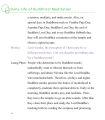Buddhist precepts : ค้นหาหนังสือธรรมะ หน้า 2 / 4
หน้าหนังสือทั้งหมด

140
Making the Five Precepts Easy for Children to Understand
12345
Chapter 33
Making the Five Precepts Easy
for Children to Understand
Once, I had the chance to observe a senior monk simplify
the Five Precepts for the children. The writer was impressed
with the
In this chapter, a senior monk teaches the Five Precepts in a simple manner suitable for children. The intention is to provide a guideline for parents to help their children understand these important

143
Understanding the Five Precepts
The children
The senior monk
The children
The senior monk
: Yes, he will.
:
And have you ever lied to him?
Yes, I have.
Remember this, if you lie to somebody,
they will feel less love for you each tim
This passage discusses the significance of the Five Precepts in Buddhism, focusing on honesty and the consequences of lying. The text outlines how adherence to the first four precepts — not killing, s

137
The Five Precepts That Parents Should Know
The Five Precepts That Parents Should Know
Teaching their children to abide by the Five Precepts is the utmost important responsibility of parents to help counteract social deterioration. However, be
Teaching children the Five Precepts is essential for parents to combat social decline. Parents must first understand the meaning of a precept, its connection to human nature, and the consequences of n

23
The Power of Honest Work and Meditation
When doing honest work the mind becomes less clouded, becoming brighter, which will help facilitate the practice of meditation. This will be the beginning step to reach the inner light and the absolut
Honest work illuminates the mind, paving the way for successful meditation. This journey creates good habits and positive energy, fostering happiness and health. Conversely, dishonest actions breed ne

63
Understanding Paccekabuddhas in Buddhist Philosophy
V. Reference 2: Dhammakāya and Paccekabuddhas
A Paccekabuddha is counted as one of the two types of Buddhas. According to Buddhist philosophy, a Paccekabuddha is a person who is of the highest wisdom
This text discusses the concept of Paccekabuddhas, individuals of high wisdom who achieve self-enlightenment but lack the ability to teach. It explores scholarly arguments about the pre-Buddhist origi

84
Bibliography of Buddhist Studies
Bibliography
Dutt, Nalinaksha. Mahayana Buddhism. Delhi: Motilal Banarsidass, 1978.
Geiger, Wilhelm. “Dhamma and Brahman.” Zeitschrift flour buddhismus (1921): 73-83.
Gombrich, Richard. “The Buddha’s
This bibliography encompasses significant scholarly works in Buddhist studies, offering insights into various aspects such as the early Buddhist philosophy, the concept of Dharmakāya, and teachings of

87
Buddhist Manuscripts in China: Theravāda Buddhism in Sipsong Panna
Buddhist Manuscripts in China: A Case Study of Theravāda Buddhist Manuscripts in Sipsong Panna (Xishuangbanna, Yunnan Province, PRC)
Joe Zhou Ya
China, like many other countries in the world, is a c
This article delves into the rich tapestry of Buddhist culture in China, specifically focusing on the Theravāda Buddhism of the Dai people in Sipsong Panna, Yunnan Province. Buddhism's introduction to

95
Dai Buddhist Manuscripts in Yunnan's Dehong Prefecture
It is noteworthy that there is a community of Dai people in the Dehong Autonomous Prefecture in the west of Yunnan, and a wide range of Buddhist manuscripts are stored there. Palm-leaf manuscripts are
This text discusses the unique tradition of Buddhist manuscripts among the Dai people in Dehong Autonomous Prefecture of Yunnan, where various types of manuscripts are produced. Most texts utilize sa-

131
Eastern Han Buddhist Meditation and Daoism
Eastern Han Buddhist meditation and Daoism
By the middle of the first century CE, a Buddhist community was already in existence in China, and growing. The arrival of translators from Central Asia and
By the first century CE, Buddhism had begun to take root in China, with translators arriving from Central Asia and India to convert texts into Chinese. They initially faced challenges in accurately co

44
Daily Life of Buddhists Meditation
Daily Life of Buddhists Meditation
Monica
a sermon, meditate, and make merits. Also, on
special days in Buddhism such as Visakha Puja Day,
Asarnha Puja Day, Buddhist Lent Day, the end of
Buddhist Lent
In Buddhism, monks strive to liberate themselves from suffering and attain Nirvana, similar to the Lord Buddha. Their daily routine includes morning prayers and meditation, going on alms rounds, clean

164
Characteristics of Fruitful Elderly Individuals
The second type of elderly person is called "A Fruitful
Person," a philanthropist or altruist.
Throughout their lives, these elderly people have
diligently earned their livelihood, and are well prepar
The text discusses the qualities of 'Fruitful Persons,' elderly individuals who exemplify self-sufficiency and altruism. They live by Buddhist principles, offer alms, adhere to precepts, and meditate

164
Understanding the Fruitful Elderly: A Guide to Altruism and Wisdom
The second type of elderly person is called “A Fruitful Person,” a philanthropist or altruist. Throughout their lives, these elderly people have diligently earned their livelihood, and are well prepar
The second type of elderly individual, termed 'A Fruitful Person', exemplifies philanthropy and self-sufficiency. These individuals have not only prepared well for their later years but have also enga

73
Understanding Dharma and Buddhist Practices
gratitude; there is life after death; heavens and hells exist, and enlightenment is attainable.
Dharma
*Dharma* (Pali, Dhamma) has many meanings: the Truth, the way of the Nature, the right way of l
Dharma, meaning Truth and the way of Nature, is central to Buddhism. Buddhists are guided by three main practices: doing good, avoiding evil, and purifying the mind through meditation. They adhere to

146
Truth for the Family: The Five Precepts
Part Five: Truth for the Family
of infringing upon all the other precepts. Hence, the
Fifth Precept reminds us not to consume intoxicants
to maintain our true nature.
Thus the Five Precepts are:
1. Do
The Five Precepts offer a framework for living an ethical life that enhances our humanity. They include refraining from killing, stealing, adultery, lying, and consuming intoxicants. Adhering to these

97
Ten Ways to Perform Good Deeds
Powerless - being jealous in others' success; having ill will
High social standing - being respectful to the virtuous; humble
Low social standing - being arrogant and disrespectful to the virtuous; la
This text outlines ten good deeds that enhance merit, including acts of giving, adherence to moral precepts, and mental cultivation through meditation. It emphasizes the importance of generosity in co

10
Congratulatory Letter for Dhammachai International Research Institute
**Congratulatory letter**
The 60th Dhammachai Education Foundation of Australia and New Zealand has developed an increasing commitment in recent years to the academic study of the Buddhist tradition,
The 60th Dhammachai Education Foundation of Australia and New Zealand has strengthened its commitment to studying the Buddhist tradition. The foundation established the Dhammachai International Resear

252
Exploratory Insights into Early Buddhist Texts and Practices
Jantrasrisalai, Chanida. 2011. “Criteria for Identification of Elements of Dhammikāya Meditacionds., Early Buddhist Traces of Dhammikāya Meditation : Project Overview.
Keenam P. John. 1982. Original p
This text presents an overview of significant scholarly works on early Buddhist practices and literature, focusing on the criteria for identifying elements of Dhammikāya meditation and examining the p

10
Delicate Love and Buddhist Values in Relationships
Delicate Love
Buddhist traditions serve as wonderful guidelines for
a couple's married life. If we are to study Buddhist
traditions, we will learn to distinguish which actions
are appropriate and inap
Delicate Love discusses the guidance provided by Buddhist traditions for couples in their married life, emphasizing ethical actions and the importance of The Five Precepts. It contrasts modern views o

70
Teaching Children Financial Responsibility
trees, and every single dollar is hard-earned by their parents.
Children will then know the value of money and will use it
wisely.
2. Teach children not to spend lavishly. Please don't
buy anything lu
เนื้อหาแนะนำวิธีการสอนเด็กถึงคุณค่าของเงิน การใช้จ่ายอย่างประหยัด และการออมเงิน โดยเริ่มจากการสอนให้เด็กทราบถึงคุณค่าของเงินและการใช้ของอย่างมีประสิทธิภาพ การให้เด็กทำของเล่นเอง การส่งเสริมการออมผ่านห

88
Overview of Theravāda Buddhist Manuscripts in China
I will give a brief overview of the manuscripts that have been
discovered and catalogued, an explanation of some current research
projects, and I will discuss some of the problems that threaten
China'
This document provides an overview of Theravāda Buddhist manuscripts found in China, particularly in Yunnan Province. It discusses the significance of these manuscripts within the Dai community and hi
